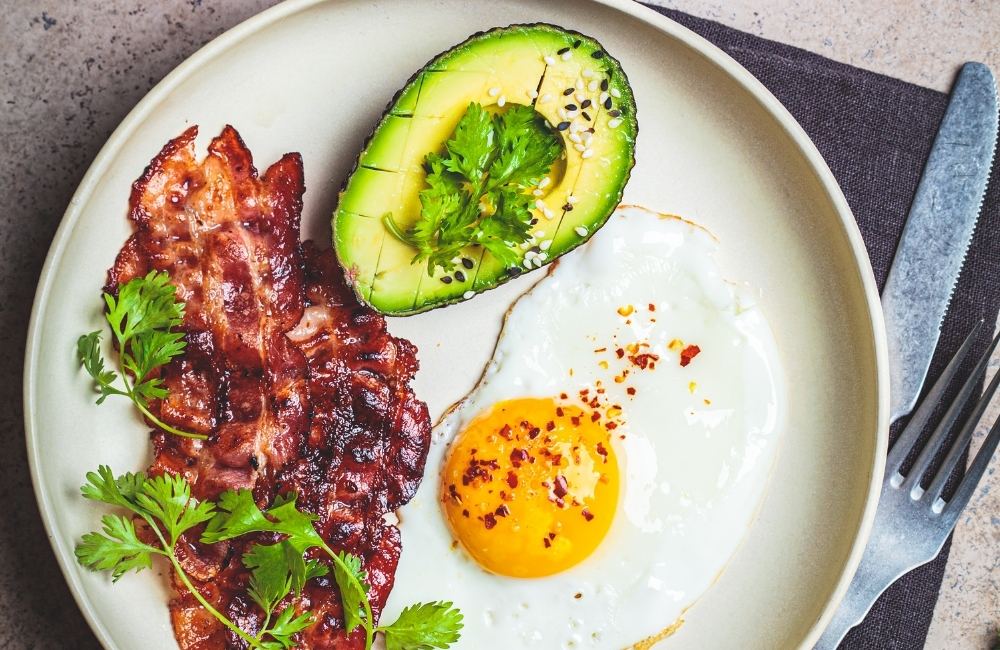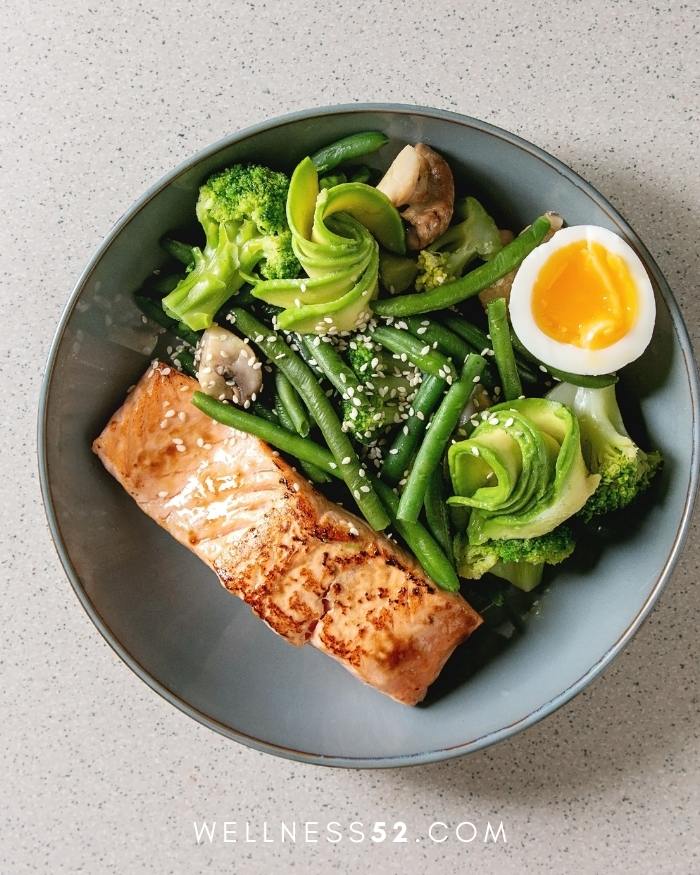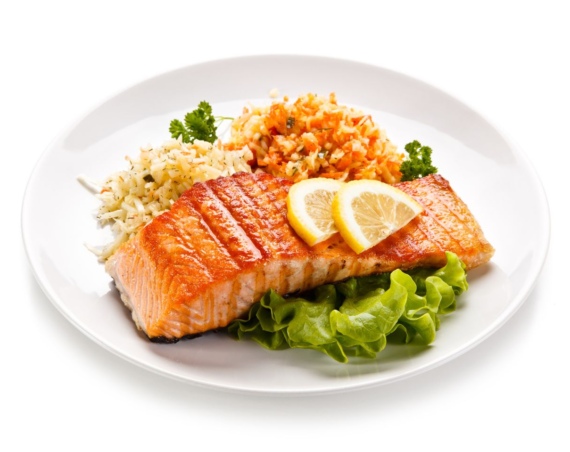
So you want to try keto for a week…
Chances are that you’ve heard of a keto diet.
You may know that it involves some kind of low-carb aspect. But perhaps the science behind it has left you confused and unsure if it’s right for you.
If this is the case, you’ve found the perfect place to begin!
This article will review what keto is and how to start following a keto lifestyle in a way that’s not overwhelming.
What Is a Keto Diet?
Diets that come with loads of rules are not fun for anyone. In this case, knowing some of the science behind the keto diet will help you to understand its guidelines.
And that starts with how your body makes energy from the food you eat.
Typically, your body burns glucose for fuel. The same glucose that comes from carbs (sugars).
That means that following a low-carb diet pushes your body to use an alternate fuel source. In this case, it’s fat.
When your body switches from burning carbs to burning fat, it is said to be in “ketosis.”
Breaking down fat produces ketones, which the body then uses for energy. And this backup metabolism method is a highly efficient way to lose weight through fat burning!
Keto macros
While following a ketogenic diet, you’ll be eating a diet that’s high-fat, moderate-protein, and low-carb. As a percentage on a daily basis, it breaks down like this:
- Fat – 60-75% of calories
- Protein – 15-30% of calories
- Carbs – 5-10% of calories
It’s better to think of these percentages across a daily total, rather than per meal.
But, as you might remember, we promised a diet free from the rules! So don’t become hung up with these macros when you start out.
Yes, you will want to avoid carbs while on this diet, but it’s important which ones.
For instance, any high-glycemic foods you’ll want to eliminate completely.
These include pasta, rice, and bread. It can be hard to stop eating these carb-loaded foods, but the high-fat part of the keto diet will keep you satisfied.
The carbs you will eat will consist of low-starch veggies like leafy greens and broccoli.
Cauliflower is another keto-friendly veggie that is super versatile. As far as protein intake, you’ll focus on lean chicken, fish, tofu, and beef.
Healthy fats make up the majority of calories consumed. Cheese, avocado, oil, nut butter, seeds, and pastured butter are all considered great fat sources.
For examples of keto-friendly foods, check out this list.
What to Focus on for Week One
You want to set yourself up for success when trying a new way of eating. Following a keto diet for the first time is no different.
There is an adjustment period when you begin to wean off carbs, which can be more mental than physical!
So for this week, keep it simple. No calorie-counting, restricting portions, or fretting over whether you’ve reached ketosis.
What to Focus on Instead Falls into Three Steps:
- First, cut out all the naughtiest carbs. This list includes heavy starches like potatoes, pasta, bread, and rice. Say no way to add sugars, and also limit fruit intake. Become familiar with labels—sugar has a sneaky way of showing up where you least expect it!
- When it comes to eggs, veggies, cheese, nuts, avocados, meats, and fats—have at it!
- Limit snack options to cheese, nuts, or meat. String cheese can be wrapped in a number of cold cuts for a great snack on the run. Eat avocados and handfuls of nuts anytime you feel hungry between meals.
1-Week Keto Diet Menu

The following meal plan keeps your carbs at 50 or below daily. You may find yourself in ketosis at this amount, or not.
Everyone’s different when it comes to limiting carbs for this reason.
You’ll notice that meals are based around veggies, cheese, meat, nuts, and dairy.
Some alterations are permitted based on allergies, etc. But, for the most part, try to stick to this plan.
Monday
- Breakfast — 2 fried eggs (cooked in pastured butter) and a helping of sautéed greens.
- Lunch — Grass-fed cheeseburger with sautéed mushrooms, and avocado, hold the bun. Serve on a bed of greens.
- Dinner — Green beans sautéed in coconut oil with pork chops.
Tuesday
- Breakfast — Omelet with mushrooms.
- Lunch — Tuna salad made with celery and tomato on a bed of greens.
- Dinner — Roasted chicken in cream sauce with sautéed broccoli on the side.
Wednesday
- Breakfast — Bell pepper stuffed with eggs and cheese.
- Lunch — Hard-boiled eggs, turkey, avocado, and blue cheese on a bed of arugula.
- Dinner — Salmon, grilled, with a side of spinach sautéed in coconut oil.
Thursday
- Breakfast — yogurt (full fat) topped with keto granola.
- Lunch — Steak bowl: add cauliflower rice, cheese, avocado, herbs, and salsa.
- Dinner — Steak (bison) with broccoli and cheese.
Friday
- Breakfast — Baked avocado boats with egg.
- Lunch — Chicken Caesar salad.
- Dinner — Pork chops with a side of veggies.
Saturday
- Breakfast — Cauliflower “toast” with cheese and avocado.
- Lunch — Pesto salmon burger (bunless).
- Dinner — Meatballs and zoodles with parmesan cheese.
Sunday
- Breakfast — Chia pudding made with coconut milk, topped with walnuts and coconut.
- Lunch — Cobb salad: made with hard-boiled eggs, avocado, turkey, and cheese.
- Dinner — Chicken coconut curry.
Are you surprised at the mouth-watering variation in these keto dishes? Don’t be! Eating keto doesn’t mean eating flavorless foods.
Even if you’re a vegetarian, there is a wealth of keto recipes to choose from.
If you’ve got room for more carbs in your day, consider eating a cup of berries in the morning. You can also add a couple of extra (more starchy) veggies to your lunch and dinner meals, too.
A Final Few Words
The most important thing to remember during the first week is this. Don’t give up! There’s a reason “carb addiction” is a common phrase these days.
And it can feel dicey when you are in the thick of a carb-elimination week, no doubt.
It’s normal to feel spacey, tired, and slow the first week. But, these feelings are actually a good sign—they mean you’re transitioning into ketosis.
While the transition itself can be hard, staying in ketosis certainly doesn’t feel this way forever. By the end of the first week, you’ll likely feel a surge of energy.
And once you see those scale numbers dropping, you’ll take heart that it is definitely worth it!
Remember to drink water, water, and more water. Otherwise, most of the weight you see fall off will just be water weight.
People with more to lose will lose it quicker, just like any diet. So if you’ve not got much to lose, stay the course!
For most, it takes about 2-3 days for your body to go into ketosis.
That’s with a carb restriction of 20 grams or less, though. If you’re eating more carbs than that, it can take just a bit longer.
But anyone who follows the sample menu above will reach ketosis by the week’s end!


